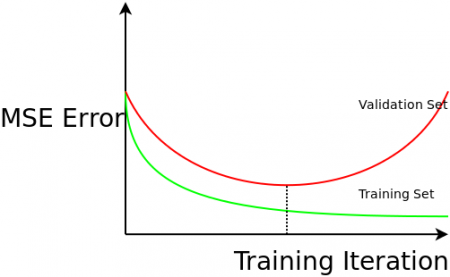I have been irritated that many recent introductions to machine learning/neural networks/whatever that fail to emphasise the most import trick in machine learning. Many internet resources don’t mention it, and even good textbooks often don’t drill it in to the reader the absolute criticality to success the trick is. In a machine learning context, we wish a learning system to generalise. That is, make good predictions on data it has never encounter before, based on what it learnt during from a training set. There is no easy formula to predict the ability of a learning system to generalise, but you can estimate it using held out data. That held out data is labelled but it is not used in training. It is called the validation set.
The validation set is the main trick. With a validation set in hand, you ask a learning system to make predictions on data you already know the answers to. That gives you a bound of how good the system will be in general.
The importance of estimating a learning systems ability to generalise was not obvious to the early pioneers. Vladimir Vapnik (the V in VC dimension), somewhat sarcastically describes the mindset of the 1970s applied learning community in the following excerpt from “The Nature of Statistical Learning Theory”
“To get good generalization it is sufficient to choose the coefficients … that provide the minimal number of training errors. The principle of minimizing the number of training errors is a self-inductive principle, and from the practical point of view does not need justification. The main goal of applied analysis is to … minimize the number of errors on the training data”
NOTE: This is the absolutely the worst thing to do, but I did it when first learning neural networks, and I have seen other beginners do it too. If the pioneers of AI, me and other beginners did not realise validation sets were absolutely necessary, so might others. That is why I am angry every time I see a “beginners guide to machine learning” that does not mention validation sets, because without that measure, the learning process will never generalise.
Here is evidence as to why estimating generalizability is critical. In an iterative training procedure like neural network back propagation, the parameters of the learning model are fiddled with to reduce training error. If you leave it running long enough, you will get near zero training error. If you plot the training error, and validation error, against the number of training iterations you get the most important graph in machine learning:
Training error goes down over time, but if you over train, the performance on unseen data gets worse! The system loses the ability to generalise, because the learning system has fitted the noise in your data, not the underlying process. This is called over-fitting. There is no way to know that iteration 1346 was going to be the one that degrades performance. You can only know if you are measuring validation error as you go.
Validation is critical regardless of the technique you are using. Validation can tell you the best “k” for k-nearest neighbour classification, and the best “k” for k-means. It can tell you which technique from the dizzying array of possible techniques works best for your data. Don’t do machine learning without understanding the most important conceptual leap that was made in the field!
Remarks
Theory driven machine learning like Bayesian model selection inherently understands over-fitting and addresses it without the need of a validation set. However, even the most hardcore theorists agree is a good idea to double check your generalisation error using a validation set. You would be mad not to.


I never saw a “beginners guide to machine learning that does not mention validation sets”
There are a few other things you should be angry about as well. Nobody ever mentions “No Free Lunch Theorem” and “Inductive Bias”. Machine learning algorithms are not magic and like all algorithms they are bound by the laws of computation and no matter how clever you think you are being you can not help but infuse your algorithm with assumptions from some kind of meta-model.
Short and to the point. Thanks for the post
Cross-validation should appear in the basic part of linear models if the person is learning ML step by step.
This is a good point – the importance of cross-validation is often understated/under-represented in courses. In a real-world model building process its quite crucial. I wouldn’t call it a trick 🙂 (maybe I am just being overly pedantic about the terminology) but its definitely something that needs to be emphasized for an end-to-end solution.
(I wanted to post on HN really but I seem to have been hell-banned for some reason!)
This is so true, but the article barely scratches the surface. More here http://videolectures.net/stanfordcs229f08_ng_lec03/ or search for bias variance tradeoffs.
I have read only http://www.cs.waikato.ac.nz/ml/weka/book.html but test, train and validation data set is mentioned there.
i dont understand the point of this article. validation is something that is covered all the time by most textbooks or resources.
If you have not taught AI then you don’t understand where beginners go wrong.
Also if you read the article properly I even acknowledged validation is in every text book…. just learners don’t seem to take the info in for some reason.
really nice beginner tip about cross validation but the tone of the article is rather annoying.
Hehe, I agree, it has annoyed a lot of people. If you look at all the articles I post on this website, I write them all in quite different styles. This one was a test of link bait title, condescending tone and a very small but focussed point. Interestingly it was top read article of last year I wrote, the only other one that came close to that amount of coverage was probabilistic scraping (http://edinburghhacklab.com/2013/09/probabalistic-scraping-of-plain-text-tables/)).
Probabalistic scraping was a seriously nice piece of work that I am proud of, but it got 1/4 the traffic. However, the silver lining is that although only a few people got it, it does much better on google ranking and that article continues to pull people to the website (although it would take 30 years to catch up to “the main trick”). I have done other good technical pieces too, but generally those do not do well at getting eyeballs, though I continue to try.
Thanks for your interest!